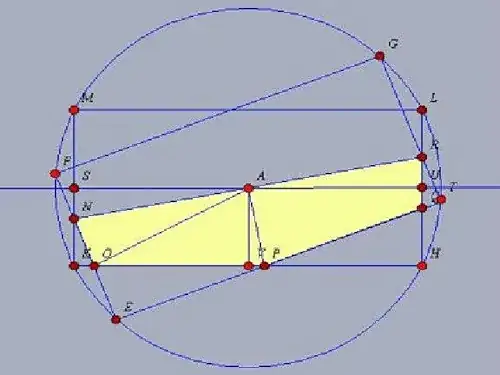The minimum area occurs when $\alpha=\frac{\pi}{4}$ and it is equal to $S_\rm{min}=a^2/2$
Why? Well I solved this problem using a parametric CAD system and then using geometry. If the height of the towel is $a$ and the width is $b$ with $a<b$ then the critical aspect ratio is $\eta_c=\tan^{-1}\left(\frac{a}{b}\right)$. When the fold angle $\alpha\leq\eta_c$ then the common area is
$$ S_1 = \dfrac{2 a b\cos\alpha-(a^2+b^2)\cos\alpha}{4\cos\alpha (2\cos^2\alpha-1))} $$
but when the fold angle is $\alpha > \eta_c$ then the area is
$$ S_2 = \dfrac{a^2}{4\cos\alpha\sin\alpha} $$
which has a minimum at $\alpha=\pi/4$. The key to the solution is finding the coordinates of the point where the two long sides of the towel intersect after the fold (point $P$ above). This calculates to: $P=(\frac{a}{2}\tan\alpha,\,-\frac{a}{2})$ in a coordinate system in the middle of the towel.
In the end I take the area of half a tower and subtract the triangular parts that stick out. The math I used are based on homogeneous coordinates for the lines, such that a line $L=[A,B,C]$ has an equation equal to $[A,B,C]\cdot[x,y,1]=0$ or $Ax+By+C=0$.
Two points $P$ and $Q$ join with the line $$\rm{JOIN}(P,Q)=\left[P_2-Q_2,Q_1-P_1,P_1 Q_2-P_2 Q_1\right]$$ where $P=(P_1,P_2)=(x_P,y_P)$ and the similarly for $Q$.
Then two lines $L$, $K$ intersect at $$\rm{MEET}(L,K)=\left[\dfrac{L_2 K_3-K_2 L_3}{L_1 K_2 - L_2 K_1}, \dfrac{K_1 L_3 - L_1 K_3}{L_1 K_2 - L_2 K_1}\right]$$ where $L_1$, $L_2$ and $L_3$ are the components of line $L$ and similarly for $K$.
The area of a triangle with vertexes $A$, $B$ and $C$ is
$$ \rm{AREA}(A,B,C) = \frac{1}{2}\left( (B_1-A_1)(C_2-A_2)-(C_1-A_1)(B_2-A_2) \right)$$ that comes from the derivation of the cross product of the vectors $B-A$ and $C-A$.
In addition, the following is true:
The folding line has coordinates $L=[-\sin\alpha,\cos\alpha,0]$.
Point $E$ has coordinates $E=(-\frac{b}{2}\cos2\alpha+\frac{a}{2}\sin2\alpha,\,-\frac{b}{2}\sin2\alpha-\frac{a}{2}\cos2\alpha)$
Point $T$ has coordinates $T=(\frac{b}{2}\cos2\alpha+\frac{a}{2}\sin2\alpha,\,\frac{b}{2}\sin2\alpha-\frac{a}{2}\cos2\alpha)$

P.S. I was trying to post an answer and I accidentally posted my comment in the answer section... Vote to delete it, please.
– Patrick Da Silva May 15 '11 at 01:32